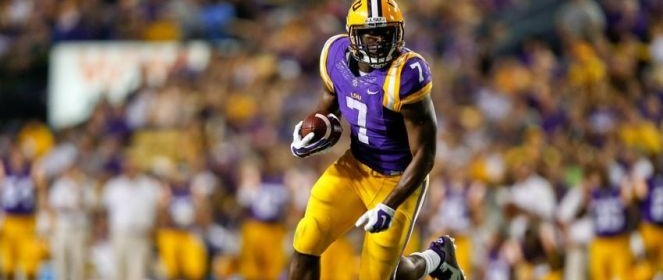Three Heisman Finalist Announced, LSU RB Leonard Fournette Shutout of New York

Written by Ryan Wright
Twitter: @HogManInLA
The Downtown Athletic Club announced their three finalist for the 2015 Heisman Trophy Award on Monday with a couple of snubs left off the distinguished list. The three players still in the running for the Heisman are Alabama running back Derrick Henry, Clemson quarterback Deshaun Watson, and Stanford running back Christian McCaffrey.
Hard to argue against the three finalist named as each player is well deserving of their ticket to New York but one snub includes Navy quarterback Keenan Reynolds, more of a longevity and career accomplishment vote, but perhaps the biggest snub was LSU sophomore running back Leonard Fournette.
The Heisman Trophy Award means different things to different people. Some college football fans and voters view it as a MVP award while others view it as an award for the best player in college football or the best player on the best team; although similar there is a distinction between the different trains of thought. Take Henry, McCaffrey, or Watson off their respective teams and each squad is a different unit on offense but taking away Fournette from LSU and the Tigers might have been lucky to have won five games during the 2015 season. Can the same be said for all of the other Heisman candidates?
The Candidates
Derrick Henry led Alabama to the college football playoffs picking up a SEC West Division title and a SEC Championship title along the way. Alabama head coach Nick Saban and offensive coordinator Lane Kiffin tightened their rotation down the back stretch riding Henry for 38 carries against LSU (Nov. 7), 46 totes against Auburn (Nov. 28), and another 44 carries in the SEC Championship Game against Florida (Dec. 5). Henry responded with 210 yards and three touchdowns against the Tigers, 271 yards and one score in the Iron Bowl, and 189 yards with another touchdown against the Gators.
Henry led the nation with 1,986 yards and 23 touchdowns on the ground but also was tops in FBS in carries with 339. Despite his high number of carries, especially down the back stretch of a long season, he still managed to average 5.9 yards per carry on the season.
Christian McCaffrey’s season was equally as impressive but in a different way. The all-purpose back was second in the nation with 1,847 rushing yards and eight touchdowns on the ground off 319 carries, second most carries in FBS. The sophomore sensation also had a team-high 41 receptions for 540 yards with four more touchdowns. If that was not enough, McCaffrey also led his team in punt return yards (67) and kick return yards with 1,042 off 36 attempts with a 98-yard touchdown. The 3,496 yards gained set a NCAA Division-I single-season record for all-purpose yards breaking Barry Sanders 1988 mark of 3,250 yards playing running back for Oklahoma State.
There was no equal to McCaffrey this season from an offensive production standpoint. The next closest player in total yards was San Jose State senior running back Tyler Ervin. Ervin had 2,410 total yards netting 1,469 rushing, 337 receiving, and 597 kick return yards.
Tough to hem in Deshaun Watson. Watson had a solid all-around season passing for 3,442 yards, ranked No. 16 in the nation, with 30 touchdowns against 11 interceptions. Watson was the second leading rusher for the Tigers with 887 yards but could have had 977 yards sans being sacked 12 times.
Watson has one thing no other player in the running has going for him, an undefeated season. The Tigers are 13-0, 8-0, and head into the college football playoffs as the team to beat.
Where voters may have been blinded by the bright lights of all the conference championship games before having to have all ballots in on Monday, Leonard Fournette was waiting on the sidelines through no fault of his own.
How Fournette Stacks Up Against the Competition
Watson finished No. 9 in total offense among all qualifying quarterbacks but would not have led the Big 12, Pac-12, SEC, American Athletic Conference, Conference USA, Mid-American Conference, or the Sun Belt Conference in total passing yards. The only other major conference, other than the ACC, he would have led was the Mountain West.
Stanford had a fantastic season going 11-2 with big wins over then- No. 6 USC, No. 18 UCLA, No. 6 Notre Dame, and No. 20 USC (again). Trouble is, the only highly ranked defense the Cardinal faced this year was Northwestern, who finished No. 11 in total defense. Stanford lost 16-6 in Week 1 on the road to the Wildcats. McCaffrey was held to 66 yards rushing on 12 carries without a score and had five receptions for 23 yards. The super sophomore did have 90 kick return yards off four attempts.
The next toughest defensive team Stanford faced was No. 28 Washington and then No. 38 Notre Dame. McCaffrey had a big game against the Huskies rushing for 109 yards on 22 carries with a score and caught five passes for 112 yards with another touchdown. McCaffrey had a solid all-around game against Notre Dame rushing for 94 yards on 27 carries, a 3.5 yard per carry average, and had three receptions for 19 yards.
There is no arguing that Derrick Henry is a workhorse. Listed at 6’3”, 240 pounds, the Yulee, Florida, native always seems to be falling forward when tackled. Henry went over 100 yards rushing nine times with two other games finishing at 96 yards (Middle Tennessee) and 95 yards (Arkansas). In blowouts against Louisiana-Monroe (34-0) he had just 13 carries and against Charleston Southern nine carries for 68 yards. The biggest highlight for Henry is four games over 200 yards rushing, all against SEC competition.
Against tough defenses Henry banged for 148 yards against Georgia, ranked No. 8 in total defense, and 189 yards against Florida, ranked No. 6. Against a similarly ranked total defense, as compared to McCaffrey, Henry had 236 rushing yards against a Texas A&M defense ranked No. 42.
The “Forgotten One”, Leonard Fournette, posted the third highest number of rushing yards in the nation, 1,741 with 18 scores, in just 11 games. Henry and McCaffrey both have two extra games played over Fournette. If Fournette had two extra games played, per his 158 rushing yards per game average, he would have had 2,057.55 yards on the season. Fournette also had 625 kick return yards with a 100-yard touchdown return off 25 attempts and caught 18 passes for 209 yards.
Fournette only went over 30 carries in a game twice, against Florida picking up 180 yards on 31 carries and against Texas A&M adding 159 yards to his stat line. Three times this season the New Orleans native went over the 200 yard rushing mark netting 228 against Auburn off just 19 carries, 26 carries for 244 yards against Syracuse, and 233 against Eastern Michigan.
The only negative against Fournette’s season is his production against Alabama and Arkansas, two of the better run defenses in the nation. The other sophomore sensation had just 31 yards on 19 carries against the Crimson Tide and had 91 yards on 19 carries against the Razorbacks but scored a touchdown against both teams. Fournette also scored at least one touchdown in every game played except against Ole Miss (Nov. 21).
What Fournette did not have that the other players had was a more balanced offense to thrive under. LSU finished with the nation’s 110th passing attack averaging just 173 yards per game. Henry had the nation’s 73rd passing game with 214 yards and McCaffrey had the 79th, 211 yards per game. Thanks in large part to Watson, Clemson had the No. 23 ranked rushing attack in the nation.
Despite playing in two less games, Fournette still finished the season fourth in total all-purpose yards.
Heisman voters were not wrong voting Watson, Henry, and McCaffrey to New York, but leaving Fournette out seems like a terrible mistake. Sure LSU finished 8-3 and tied for third in the SEC West, so that is not impressive to some. When Robert Griffin III won his Heisman in 2011, Baylor was 10-3 and finished tied for third in the Big 12.
Photo credit: deathvalleyvoice.com; No. 7 Leonard Fournette.
